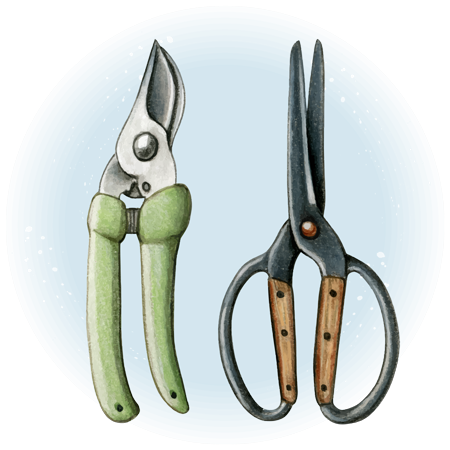Salvia Small Talk: Deadheading Deciduous or Semi-Evergreen Soft Stem Sages

Removing withered Salvia blossoms that are beginning to go to seed is called deadheading — a form of pruning. This is trimming done in late spring and summer to make plants look tidier and encourage repeat blooming during the growing season. How to deadhead a Salvia depends on its form of growth, which may be one of four types: Rosette-growing herbaceous perennial; soft-stemmed deciduous or semi-evergreen sage; deciduous, woody-stemmed sage; or evergreen shrub. Many Salvias in each of these categories can thrive as annuals in areas where winters are too cold for perennial growth. Deadheading increases bloom for your buck, especially for sages grown as annuals.
Among Salvias, “soft stem” identifies a species that has no woody growth. Soft stem Salvias that are deciduous or semi-evergreen may die to ground or drop leaves at the end of the growing season and become unattractive dry stalks. They range from cold-tolerant perennials to subtropical tender perennials — like the many kinds of Scarlet Sage (Salvia splendens) — that generally are grown as annuals in the U.S.
In addition to Scarlet Sage, here are some examples of deciduous or semi-evergreen soft stem Salvias grown at Flowers by the Sea Farm for sale online:
- Prairie Sage (Salvia azurea), a cold tolerant perennial native to the U.S.
- Forsythia Sage (Salvia madrensis), a tender perennial from Mexico’s Sierra Madre Oriental mountains
- Midnight Mexican Bush Sage (Salvia leucantha ‘Midnight’), a tender perennial native to subtropical and tropical Mexico, and
- Skyscraper Orange Sage (Salvia x ‘Skyscraper Orange’), a tender perennial hybrid likely related to several Mexican and South American sages.
You can snip entire stems of withered flowers from deciduous or semi-evergreen soft stem Salvias at any time during the growing season. However, in areas where the climate is mild, these sages grow rapidly and can develop a tangled look with many spent stems by late spring or early summer. Then cutting back the entire plant close to the ground encourages vigorous new growth and flowering. Sharp, medium-sized bypass pruners — secateurs — are best for the task.
Questions and More Information
The plant description pages in our online catalog contain a wealth of information about plant characteristics and needs. Page features include a button saying, “How to Prune this Plant.” It leads to a pop-up box identifying the plant’s form of growth and basic information about pruning.
If you have more questions about pruning or any of the plants we grow please contact us. We’re glad to listen and share what we know.

 Salvia azurea
Salvia azurea  Salvia madrensis
Salvia madrensis  Salvia leucantha 'Midnight'
Salvia leucantha 'Midnight'  Salvia x 'Skyscraper Orange'
Salvia x 'Skyscraper Orange'
Comments
There are no comments yet.